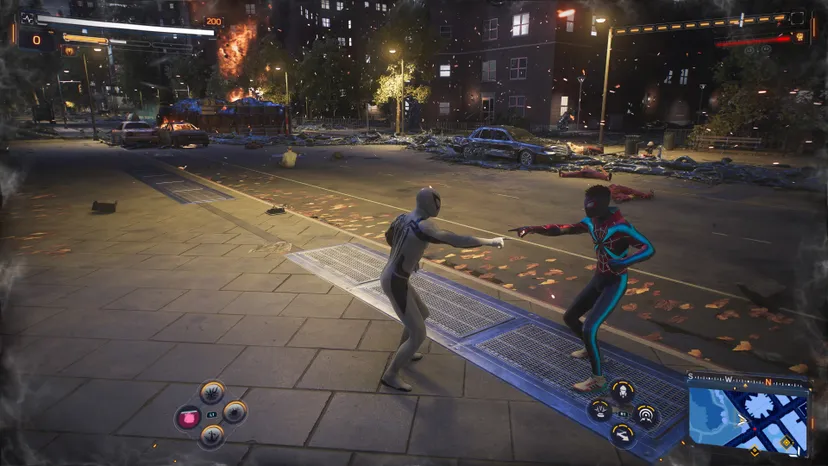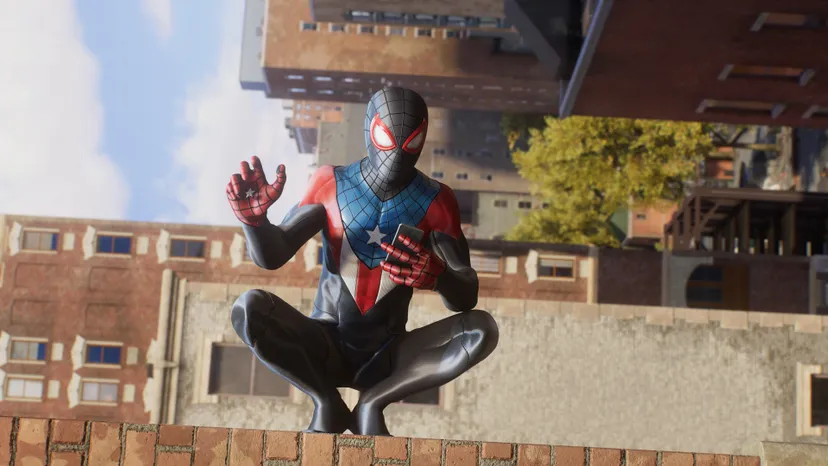
[ad_1]
The greatest challenge for any discipline in game development is the ultimate demon: math. More specifically, exponential math. As the upper boundaries of game development have become more polished and detailed, the effort needed to meet higher bars of quality requires more assets, more content, and more resources—all variables that grow exponentially larger when designers try to support features built around player choice.
Features like that can include branching narrative mechanics, dense ability trees, or—as seen in Marvel’s Spider-Man 2 from Insomniac Games—a wider roster of playable characters.
But the number of playable characters doesn’t necessarily dictate the design math that goes with them. Compare Marvel’s Spider-Man 2 to, say, TT Games’ Lego Marvel Super Heroes 2. Both games feature urban open-world environments players can traverse, both games support a wide roster of player abilities, and both games even feature multiple Spider-Men (with one Spider-Gwen in LEGO Marvel Super Heroes 2‘s cast).
But TT Games managed the scope of its wide roster by putting hard caps on the amount of dialogue and abilities in LEGO Marvel Super Heroes 2. What that studio accomplished is a technical feat in its own right, but comparing it to Marvel’s Spider-Man 2 shows how many technical and design challenges Insomniac Games took on by choosing to tell an epic tale that centered both of its heroic webheads.
To dig into the scale of assets and content needed to design dual Spider-Men, we pinged Insomniac Games senior programming director Doug Sheahan and Ryan Smith to help us break down the studio’s goals with the game.
Breaking down the differences between Miles Morales and Peter Parker
First, let’s try to compartmentalize what goes into each playable Spider-Man. Sheahan explained that Insomniac’s goal was to ensure they stayed true to each character “narratively and mechanically” while allowing players to feel comfortable switching back and forth manually or when required by the story.
Smith said questions the team tried to answer included “What should the heroes share, and what should be unique for each hero?” “How can we make sure players will feel comfortable on the controller when we switch between heroes in a story moment?” and “What options can we give players to customize each individual hero?”
To answer these questions, Insomniac Games had to produce the following for each hero:
Peter Parker:
The older (but not wiser) webhead benefits from Insomniac’s work on the first Marvel’s Spider-Man but still sees a number of gameplay upgrades.
- 34 Spider-Man suits
- 16 suits each have an additional three color palettes.
- One unique character model for general gameplay.
- This model is slightly altered midway through the game when Peter acquires the Symbiote.
- One “civilian” character model for when Peter is out of costume.
- Peter’s “civilian” character model gets an all-black look after acquiring the Symbiote.
- A suite of unique animations for each basic attack.
- These animations appear slightly tweaked when Peter possesses the Symbiote—but mostly in the effects department.
- Unique finisher animations for different enemy types.
- Unique animations for interacting with civilians.
- Unique “combo” finisher animations that play when allies are part of the fight.
- Such allies include Miles Morales, Yuri Watanabe, and a Symbiote-suited Harry Osborn.
- Sound effects for each attack and certain traversal moves
- These sound effects are also altered during Peter’s time with the Symbiote.
- Two ability trees—one built around pop-out mechanical Spider arms, and one built around the black goo of the Symbiote.
- Character audio for the main quest.
- Some of this audio is stored in two different states—depending on if Spider-Man is standing still and speaking at a normal pace, or if he’s rushing through the open world and sounding more out of breath.
- Character audio for quests only designed for Peter Parker.
- See the above note with regard to whether Spider-Man is moving or standing still.
- Character audio for quests that both Peter Parker and Miles Morales can play.
- See the above note with regard to whether Spider-Man is moving or standing still.
- Dynamic character audio for open world gameplay.
- See the above note with regard to whether Spider-Man is moving or standing still.
- This character audio also appears to change if Spider-Man is in possession of the Symbiote.
Miles Morales:
Miles saw much of his kit fleshed out in Marvel’s Spider-Man: Miles Morales, a standalone soft sequel to Marvel’s Spider-Man.
- 34 Spider-Man suits
- 31 of these suits each have an additional three color palettes.
- Character audio for quests that both Peter Parker and Miles Morales can play.
- See the above note with regard to whether Spider-Man is moving or standing still.
- Dynamic character audio for open-world gameplay.
- See the above note with regard to whether Spider-Man is moving or standing still.

Both Spider-Men:
Sheahan explained that the team decided to divide Miles and Peter’s abilities based on their respective themes but keep them mapped to the same control scheme (pressing L1 and a facepad button). He also praised the animation team for making unique traversal movements for each character, allowing both heroes to “feel authentic to their character during traversal and combat.”
- A shared control scheme.
- Shared upgrade trees that improve basic combat for both heroes.
- A shared gadget pool
- Shared sound effects for basic combat and traversal.
- A shared “animation” effect unlocked when acquiring suits inspired by the Spider-Verse films.
- A shared generic enemy pool (who have to react to the animations of attacks from each Spider-Man).
When a developer has to create that many assets for its characters, it raises the question—how can those resources be efficiently used in a massive triple-A game?
A case study of the Sandman side quest
If you’re cross-referencing the unique features of each Spider-Man, you’ll note that adding a second playable character doesn’t just mean you can look at Peter Parker’s arsenal and say, “Okay, we will need to just double the output of what’s over here.” In some instances, the content output can be as much as four times or eight times the work.
An open-world sidequest centered around Flint Marko, aka Sandman, highlights this dynamic. This quest is a follow-up from the game’s opening setpiece, where Peter and Miles team up to take down a skyscraper-sized Sandman wreaking havoc in Manhattan. After defeating Sandman, Miles finds a crystal out in the city with some of his memories buried in it—gathering these helps restore Sandman’s mental state and offers clues as to why he went on a rampage.

This is one of the major open-world quests that both Peter and Miles can complete. It, therefore, contains these components:
- A unique suite of sand enemies that respond to both Peter and Miles’ attack and ability animations.
- Unique animations for specific portions of the quest (the first and final missions).
- Unique dialogue for Peter and Miles as they navigate the quest.
- This includes dialogue with Mary Jane Watson and Flint Marko. (They appear to have the same dialogue for both characters).
- Said dialogue is doubled because of the aforementioned double audio for when a Spider-Man is standing still versus when he is on the move.
What stands out about this quest is that it’s a very efficient use of available resources that achieves three goals:
- It adds content to the game’s open world.
- It extends the use of Sandman-created assets from the game’s opening setpiece (and keeps the spotlight on an iconic villain).
- It supports a recurring theme in Marvel’s Spider-Man 2, which is that villains can be rehabilitated instead of just locked up.
The open-world activities for Miles and Peter elsewhere make use of far more unique dialogue, animations and encounters. You can also observe different efficiencies in the unique activities as well. Peter and Miles each have questlines that require a high amount of unique assets and animations, like Miles’ Mysterio-themed missions and Peter’s science experiments.
But there are quests with lower resource demands, too. Miles has a questline dedicated to recovering pieces of tech made by his uncle Aaron, and Peter has some “spend time with New Yorkers” that don’t involve unique cutscenes and recycle assets and mechanics elsewhere in the game (like a bicycle ride, or a heartbreaking mission where he chases pigeons for the last time).

One key design choice to make these encounters flow well for the player? The “fast character switching” mechanic. When players assume control of different Spider-Men in the open world, there’s a quick transition where the first Spider-Man leaps offscreen, the screen fades, then another one is introduced with a fun animation (like Peter doing crunches on the side of a tall building).
Smith said these animations were among his “favorite parts” of the dual-hero system.
What happens when multiple heroes are onscreen?
Sheahan and Smith were keen to discuss the process of dropping multiple characters into combat. Peter Parker and Miles Morales team up with each other and other Marvel heroes during their adventure. These include Yuri Watanabe, Felicia Hardy, aka “Black Cat,” and a superpowered Harry Osborn.
These heroes join the player character in the free-for-all brawls, and as Sheahan explained, “We [needed] to make sure that all our enemies can respond to the abilities of both Spider-Men in behavior and animation.” Bringing friendly heroes into the fray also required a unique AI system that wouldn’t interrupt how players choose to take on foes.
“We manage some of the scaling challenge by having lots of ways in our engine to share systemic elements while enabling artists to customize other elements,” Smith said, pointing to the various web effects as a key example. “Both heroes apply the same web status and web reactions, but we customize the display of the webs while Peter has the Symbiote suit.”
Smith said that Miles’ invisibility power required specific behavior from enemies—which had to feature in enemy AI design even if only one character would interact with it.
While fighting with friends, the player can perform unique finishers on enemies where both heroes will take out a foe with a stylish flourish. Sheahan said to make that system work, the animation team had to craft the camera animation “specifically” to give a moment where the ally character could join the finisher without the player seeing them move away from whatever they were doing before it was triggered.
“This simplifies the problem of getting your ally into position while giving the animators a lot of freedom to make highly acrobatic results,” he said.
Efficiency lessons for aspiring open-world developers
Open-world games like Marvel’s Spider-Man 2 are exceptionally popular with players but also require an ever-expanding number of developers to bring them to life. It’s worth celebrating that Insomniac Games was able to pull it off with a relatively smaller staff (and a credit list that doesn’t take 45 minutes to watch).
Anyone keen on crafting authentic open worlds may do well to study the studio’s efficiencies—where they were able to save resources while delivering an emotional impact, and where they created bespoke content that would only be used a few times. All while weaving a satisfying tale that advances the arcs of the two Spider-Men.
[ad_2]